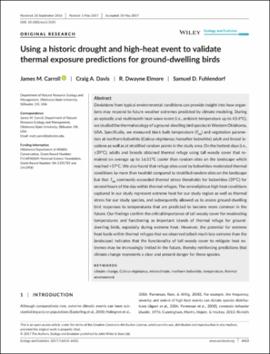| dc.contributor.author | Carroll, Matt | |
| dc.contributor.author | Davis, Craig A. | |
| dc.contributor.author | Elmore, R. Dwayne | |
| dc.contributor.author | Fuhlendorf, Samuel Dean | |
| dc.date.accessioned | 2019-08-22T17:50:44Z | |
| dc.date.available | 2019-08-22T17:50:44Z | |
| dc.date.issued | 2017-07-08 | |
| dc.identifier | oksd_carroll_usingahistoricd_2017-07-08 | |
| dc.identifier.citation | Carroll, M., Davis, C. A., Elmore, R. D., & Fuhlendorf, S. D. (2017). Using a historic drought and high-heat event to validate thermal exposure predictions for ground-dwelling birds. Ecology and Evolution, 7(16), 6413-6422. https://doi.org/10.1002/ece3.3185 | |
| dc.identifier.uri | https://hdl.handle.net/11244/321223 | |
| dc.description.abstract | Deviations from typical environmental conditions can provide insight into how organisms may respond to future weather extremes predicted by climate modeling. During an episodic and multimonth heat wave event (i.e., ambient temperature up to 43.4°C), we studied the thermal ecology of a ground‐dwelling bird species in Western Oklahoma, USA. Specifically, we measured black bulb temperature (Tbb) and vegetation parameters at northern bobwhite (Colinus virginianus; hereafter bobwhite) adult and brood locations as well as at stratified random points in the study area. On the hottest days (i.e., ≥39°C), adults and broods obtained thermal refuge using tall woody cover that remained on average up to 16.51°C cooler than random sites on the landscape which reached >57°C. We also found that refuge sites used by bobwhites moderated thermal conditions by more than twofold compared to stratified random sites on the landscape but that Tbb commonly exceeded thermal stress thresholds for bobwhites (39°C) for several hours of the day within thermal refuges. The serendipitous high heat conditions captured in our study represent extreme heat for our study region as well as thermal stress for our study species, and subsequently allowed us to assess ground‐dwelling bird responses to temperatures that are predicted to become more common in the future. Our findings confirm the critical importance of tall woody cover for moderating temperatures and functioning as important islands of thermal refuge for ground‐dwelling birds, especially during extreme heat. However, the potential for extreme heat loads within thermal refuges that we observed (albeit much less extreme than the landscape) indicates that the functionality of tall woody cover to mitigate heat extremes may be increasingly limited in the future, thereby reinforcing predictions that climate change represents a clear and present danger for these species. | |
| dc.format | application/pdf | |
| dc.language | en_US | |
| dc.publisher | Wiley Open Access | |
| dc.rights | This material has been previously published. In the Oklahoma State University Library's institutional repository this version is made available through the open access principles and the terms of agreement/consent between the author(s) and the publisher. The permission policy on the use, reproduction or distribution of the material falls under fair use for educational, scholarship, and research purposes. Contact Digital Resources and Discovery Services at lib-dls@okstate.edu or 405-744-9161 for further information. | |
| dc.title | Using a historic drought and high-heat event to validate thermal exposure predictions for ground-dwelling birds | |
| osu.filename | oksd_carroll_usingahistoricd_2017-07-08.pdf | |
| dc.description.peerreview | Peer reviewed | |
| dc.identifier.doi | 10.1002/ece3.3185 | |
| dc.description.department | Natural Resource Ecology and Management | |
| dc.type.genre | Article | |
| dc.type.material | Text | |
| dc.subject.keywords | colinus virginianus | |
| dc.subject.keywords | climate change | |
| dc.subject.keywords | microclimate | |
| dc.subject.keywords | northern bobwhite | |
| dc.subject.keywords | temperature | |
| dc.subject.keywords | thermal environment | |
